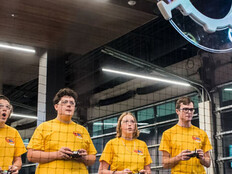Teachers Take Game-Based Learning to the Next Level
The days of video games being restricted to an after-school activity are quickly becoming numbered, as teachers continue to find fresh applications for game-based learning.
John Kielman wrote about "Minecraft"'s impact on K–12 classrooms in an April 28 article in The Chicago Tribune, saying the game's "virtual LEGOs" motivate kids through a technology that's fun and familiar to them.
Teachers have found several educational functions for the building-block game by incorporating it into lessons on ancient architecture, history and engineering, according to Kielman. And because the design of the lesson is something they're familiar with, the kids are more engaged.
That's the essence of game-based learning. It's not a new concept, but educators are coming up with fresh ideas every day to interest students and motivate them to learn.
Some have had success expanding on students’ initial interest, moving into programming lessons. Douglas Kiang, a teacher and blogger for Edutopia, wrote that his students create interactive fiction using a programming language called Inform 7.
"Inform7 has also been a wonderful way to get many girls involved in programming, since it places an emphasis on the craft of writing and the development of story," Kiang wrote. “One student created a House of the Seven Gables that you could walk through and explore.”
But sometimes a student's interest doesn’t stop with merely exploring a digital world. High school students at the Dwight School in New York City are taking their first steps into the world of game design through new courses offered this year.
The school’s tech-focused academic program taps into students’ creativity, and they're already seeing some startling results, according to a school spokesperson.
Students are given a choice of seven different game design languages to learn, including Unity, which is making waves in the mobile space. Students are also working with a professional game designer to test a game, and one has been selected as a beta tester for Google Glass.
These classes let students step away from traditional high school classes to learn skills that require them to think creatively, while teaching them in-demand career skills.
But even the most effective use of technology in the classroom can't go far without a great teacher, Kiang contends in his Edutopia post.
"The classes are not about teaching programming. They are about learning history, empathy and creativity, and about building writing skills. Coding is the language of critical thinking. It requires students to define problems, break them into parts, and be resourceful in finding the answers to their problems.
Great teaching is at the heart of all these experiences, as great teachers make connections to content, between individuals and with each child. They allow students to express their learning in their own unique ways. Together, great teaching and plentiful opportunities to code and collaborate transform the learning environment, boost engagement and build powerful skills for the future."








